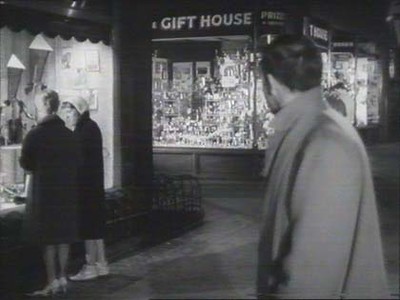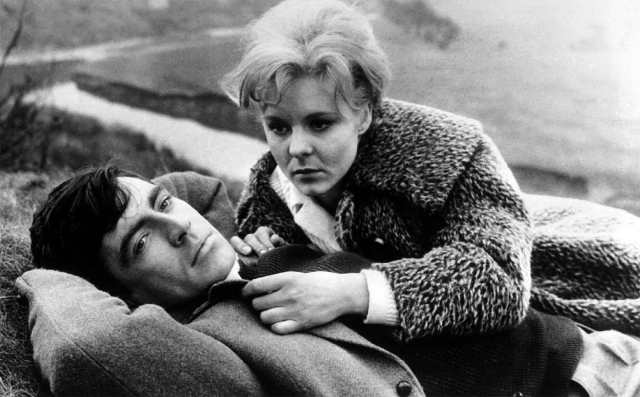One of the hallmarks of a classic film is the way it impacted the cinema of its day and all the movies on its subject that followed.
“Citizen Kane” changed the movies. “Stagecoach” became the benchmark of Westerns. And marriage, generally depicted in broad strokes — either sunny or dark — became something a lot more complicated to consider after the British “kitchen sink realism” of “A Kind of Loving” in 1962.
Based on a realistic novel by Stan Barstow, perhaps only a closted gay filmmaker in a country where homosexuality was still illegal, and a Jew in a culture still noted for its antisemitism, could have treated this subject with the sort of cynical, jaded beauty that the great John Schlesinger brought to it.
Schlesinger’s debut feature — he’d go on to make “Darling,” “Midnight Cowboy” and much later “Pacific Heights,” where I had the pleasure of interviewing him — was photographed by Denys Coop. Coop’s work on “Look Back in Anger,” “This Sporting Life,” and Schlesinger’s “A Kind of Living” and “Billy Liar” helped define an era in British film.
They moved domestic drama out of London, off of soundstages and into the stark, industrial north. Manchester and environs were the settings for its street and park life, with Fylde and Blackpool serving as the very place a working class bloke with “a white collar job” would take his bride on a honeymoon — the overcast and rocky British version of Atlantic City.
Alan Bates, very early in his run as one of the great leading men of his day, stars as Vic Brown, that “white collar” draftsman with a good job and “security” at a large, reputable firm.
But “security” isn’t on his mind, even on his beloved older sister’s (Pat Keen) wedding day. This opening scene lets us see a rowhouse (“semi-detached”) working class neighborhood dominated by its ancient church. But while the entrance of that church is where everybody is posed for wedding day photos, Schlesinger makes of point of letting all that business serve as the backdrop for the opening credits.
None of this “holy matrimony” and “sanctity of marriage” sentimentality will do. The world had already moved on from that. Now it was time for the movies to do the same.
Vic is ambitious enough to take his job seriously, outgoing enough to be “one of the lads” up for “pub crawling” after “the (soccer) match,” quick to share the latest nudie mag from France among the lot.
Vic has noticed the pretty and proper Ingrid (newcomer June Ritchie) around the office. He pines for her, stalks her to ride the same bus, and eventually fakes a “left my money at the office” excuse to get her to lend him ticket change just to start a conversation.
Among the piggish louts in his all-male department, she’s got a nickname — “the praying mantis.” Their distinction between “tarts” and “when it comes to marrying a bird, you want something else” has rubbed off on Vic. Ingrid, younger but from a more management class family, might be the one for him.
“A Kind of Loving” sets in motion what we’d now see as a most conventional screen “romance.” She’s falling in love. He might be, but his libido takes precedence. The on-and-off nature of the affair — movie dates, necking in the park, followed by an early ’60s version of “ghosting” — patiently plays out for the entire middle hour of the movie.
And then, also daring for its time, she lets him know that she’s “late.” Their affair becomes a marriage, one that might be dictated by tradition, doing “the honorable thing” and family pressure, which could also be their undoing.
Bates, a beautiful and magnificently “real” screen presence in his heyday, lets us see the confusion and calculations in Vic, handsome but too naive to be a playboy or rake, too upstanding to not do the right thing, too fragile to endure the abuse of his not-working-class mother-in-law (Thora Bird, infuriating).
She is “enough to make a bloody vicar swear,” she is. But will Ingrid see that? Will his own family?
“A Kind of Loving” was the first British film to show a flash of skin, “daring” in its “shut your cakehole” and “bloody” this and that (mild) profanity and as frank as any English speaking movie of its day about sex. One is always “careful,” but Vic chickens out and buys booze at the chemists (pharmacy) when our lad went in to buy condoms, young lovers face the dilemma of “We mustn’t” when their hormones are insisting “We must.”
Easy “divorce” is introduced, and seen for the cliche it was to become. An old mate of Vic’s admits he’s had one, and shows off the 1935 MG-PA he bought to celebrate.
“A Kind of Loving” is the sort of revolutionary classic that reminds us how hard it is to see the revolution, as it happened, from a distance. Watch the chaste romances of the mid-50s, and then catch “The Entertainer,” “The Apartment” or “This Sporting Life” and this film. A generational sea change was happening, and the plays and movies that came along were merely following it and documenting the New Normal.
The perilous war years and the lean decade and a half that followed were turning into “The Swinging Sixties,” where marriage and “love” itself were being redefined by simply taking off the rose colored glasses and seeing romance and marriage for “A Kind of Loving.”
And in this Bates, Schlesinger and Ritchie masterpiece, scripted by Schlesinger collaborators Willis Hall and Keith Waterhouse and lit and photographed by Denys Cooper, we have a gorgeous artifact of that — a patient, carefully-observed and sensitively- portrayed snapshot of a generation, culture and society shedding one value system and taking a hard look at a new one.
Rating: TV-PG, nudity, adult themes
Cast: Alan Bates, June Ritchie, Bert Palmer and Thora Bird
Credits: Directed by John Schlesinger, scripted by Willis Hall and Keith Waterhouse, based on a novel by Stan Barstow. An Anglo-Amalgamated Film now streaming on Tubi, et al.
Running time: 1:53





